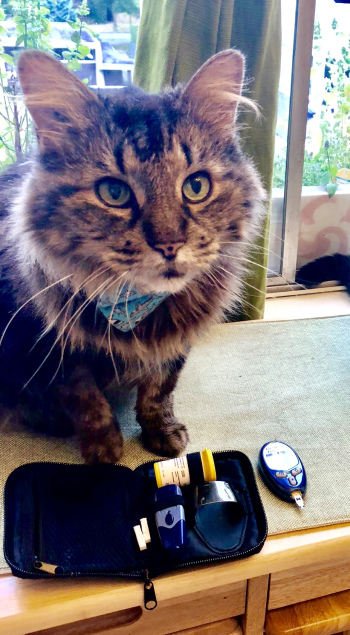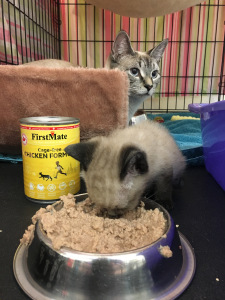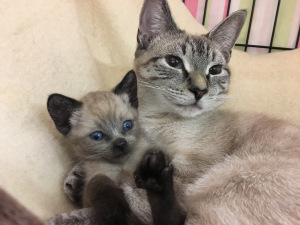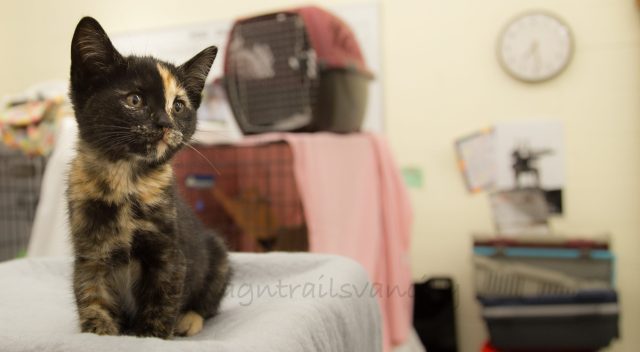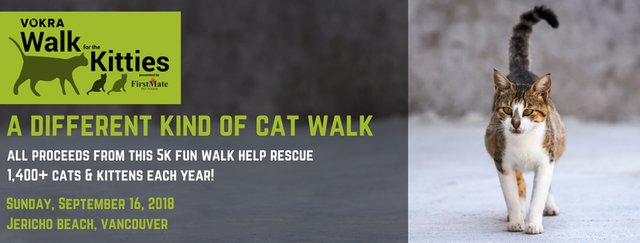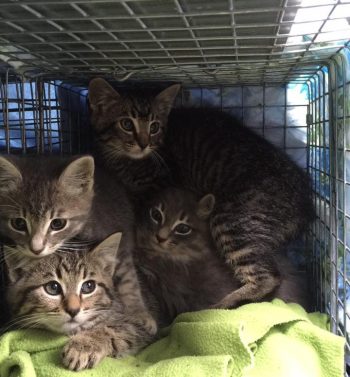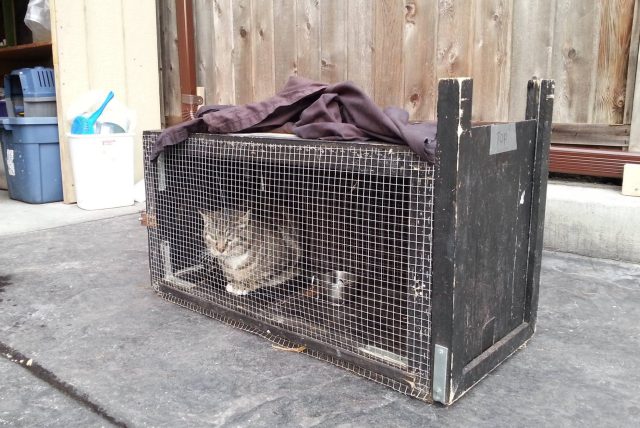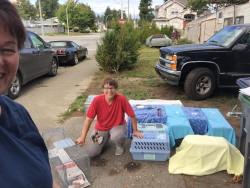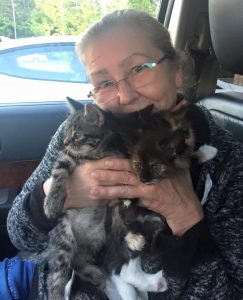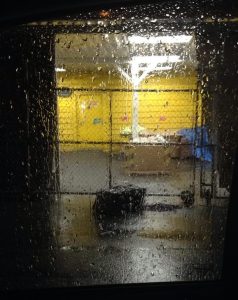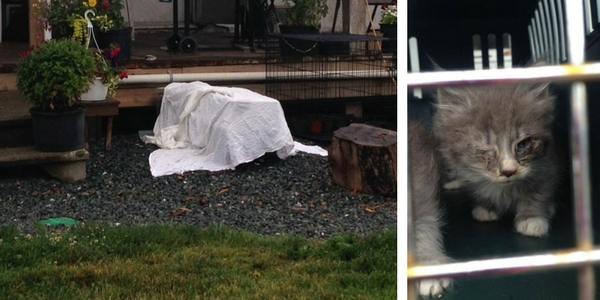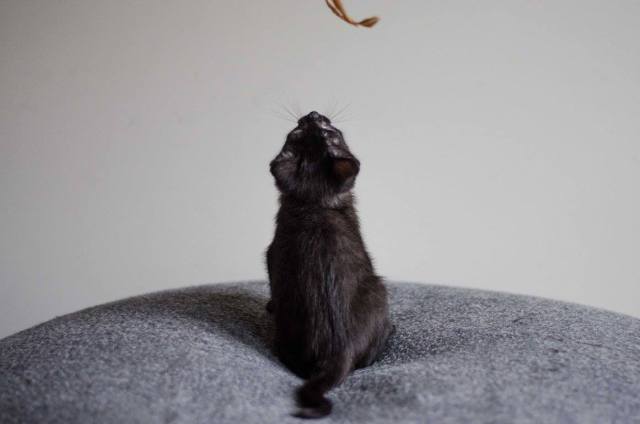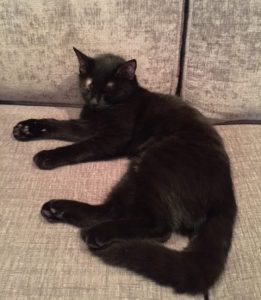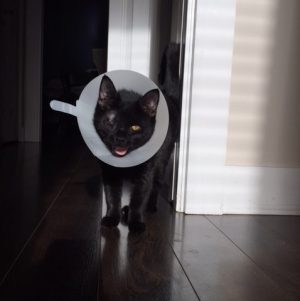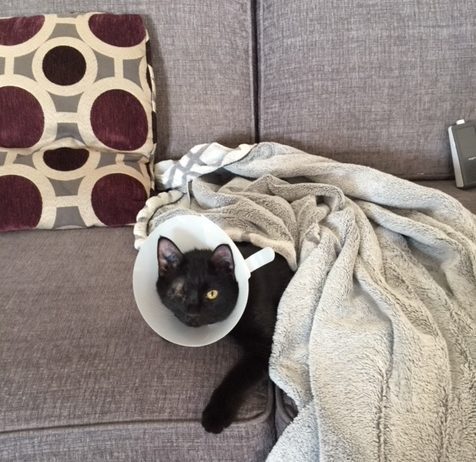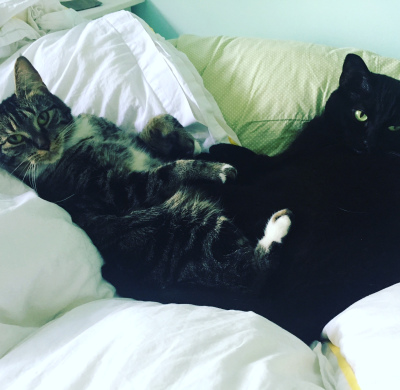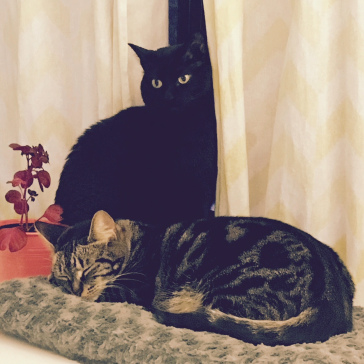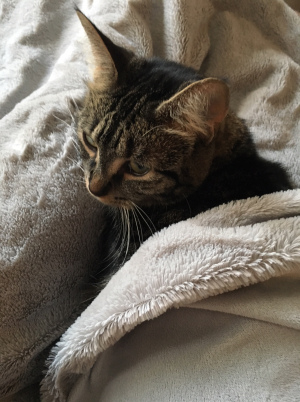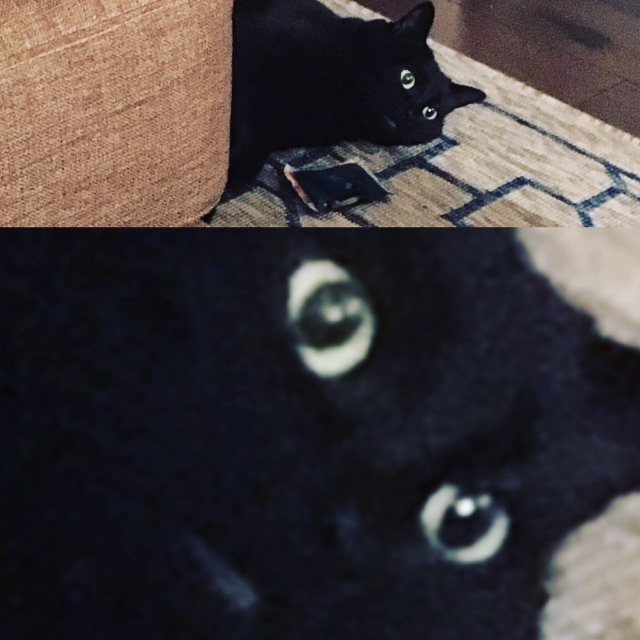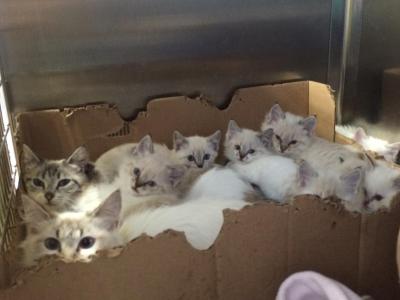
This bunch of semi-feral kittens needed lots of socialization before they were ready for adoption.
Cats and kittens are ready for adoption when they learn to trust and accept us humans. As many of the cats in our care come from the streets they’ve often had limited or negative experiences with people. By caring for them in a stable and safe home environment, our foster moms and dads are helping to charge their view of humans, which is life changing. Fostering allows these cats and kittens to grow and transform into confident kitties who will then find their forever homes.
As each cat or kitten is unique, the way foster parents socialize with them is different. For example, feral or semi-feral kitties see humans as potential predators and so they’ll run away and hide. They may hiss at you when you try to pet them or lash out by swatting or biting. In this situation the caregiver must be slow and patient. You start by sitting wherever they are – close but not too close – and make sure you have some tasty treats. As you have food, they’ll start to associate you with good things. The more they see you as non threatening, the more they’ll warm up to you. Eventually, with patience, love and persistence, an adoptable kitty emerges.
Fostering’s not only a positive experience for the kitties, but also the foster parents! It’s very rewarding to help cats and kittens get adopted. A little time and patience goes a very long way and watching them grow and learn to accept and love humans is an extraordinary feeling. Foster parents not only have immense love for kitties, but also the desire to put time and effort into giving them the best life possible. Unconditional love is given to each cat and that love changes their lives for the better.
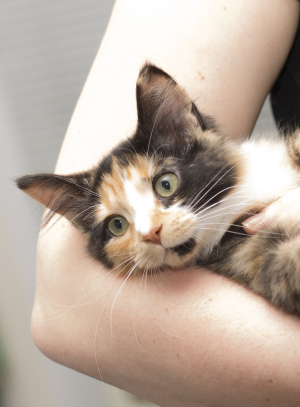
Clawdette’s one of the 26 kittens Erin’s helped save so far by fostering.
Erin, a long time foster parent, shares a memorable story:
“My very first foster turned into my very first foster fail! I took her on while living in Australia. I had some extra time on my hands, so I asked the vet clinic close by if they had a sick or higher-needs cat that needed fostering. They were so happy since they just had a feral kitten brought in. She was extremely hissy and completely terrified of humans, so they needed her to go somewhere else aside from the vet clinic. I brought her home and got her settled into the bathroom. After hiding under the sink in the bathroom for the entire first afternoon through to the night, the next day I went in there to stay with her and do my own thing while being with her. After doing that for the morning, she came out from under the sink, crawled up on my lap, had a bath, curled up on my lap and went to sleep. I knew at that moment that I would not be giving her back at all, ever. The rest is history!
She is very much attached to me (and only me) and not great with other animals. But because of my experience with her we’ve gone on to foster 26 more kittens since then. She was my introduction into fostering and paved the way for all these other kittens to come and be a part of my life. I’m grateful for every day that we have together! And seeing how she has grown from an incredibly hissy and terrified kitten to a much more confident and happy cat, has shown me just what fostering can do for a cat. It is a life changer for them!”
Sarah, a long-term VOKRA foster parent, has fostered two “pee kitties” so far. These are kitties who pee in inappropriate places for seemingly unknown reasons. After checking with a vet to make sure there are no underlying medical issues, she goes through all the other potential reasons, such as stress and anxiety, disapproval of the little box shape or litter type, habits or any other thing she can think of. She notes all the occurrences of inappropriate peeing and the surrounding circumstances to find the patterns and modify the environment as needed. She’s just like a detective!
With one foster, all the kitty required was a larger box with deeper litter. With the other kitty, Zoey, all she needed was to have all enticing soft items, such as towels and bath mats, off the floor so the only target for pee was the litter box. All these “pee kitties” simply needed was a person with the patience to understand what they want and the willingness to create a consistent environment for them.
Sarah weighs in on why being a foster parent is an amazing opportunity:
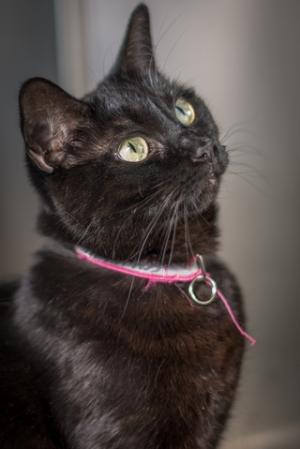
Ziggy’s one of Sarah’s former “pee kitties”. Happily she was recently adopted and now has a new forever home.
“I started fostering when I was living on my own after having moved to Vancouver by myself. I grew up with cats and adding a cat to my home seemed like a no brainer! However, as a student, I was unsure about my long-term plans so fostering allowed me to have a furry companion without committing before I was ready. It’s also so rewarding to see them improve and go off to new homes with excited new owners! And, of course, I feel like I’m helping with the larger problem of cat overpopulation and reducing strain on VOKRA as a rescue organization so that their main focus can be on those cats with greater medical needs while healthy kitties can enjoy the comfort of a home rather than a shelter environment. It also allows me to help teach others about the importance of fostering and how much fun it is!”
Fostering saves lives and we have more than 350 foster parents to thank for that! Many of our kitties need to socialize with humans and learn to accept them before being adopted and our foster homes offer the best opportunity for them get the fresh start they need. One at a time, fostering produces a transformed, adoptable kitty ready to find a loving furever home!
At VOKRA we’re always looking for new foster parents to help save more lives. We provide all the food, supplies and other equipment necessary to our foster homes, as well as ongoing support and advice. You simply provide the care, attention and love.
We have a variety of fostering situations as we take in orphaned kittens, feral kittens, pregnant mothers, mothers with kittens and adult cats. Each year we need temporary homes for more than 1,400 kittens and cats! If you’re interested in learning more about fostering, please visit our website at vokra.ca/fostering.
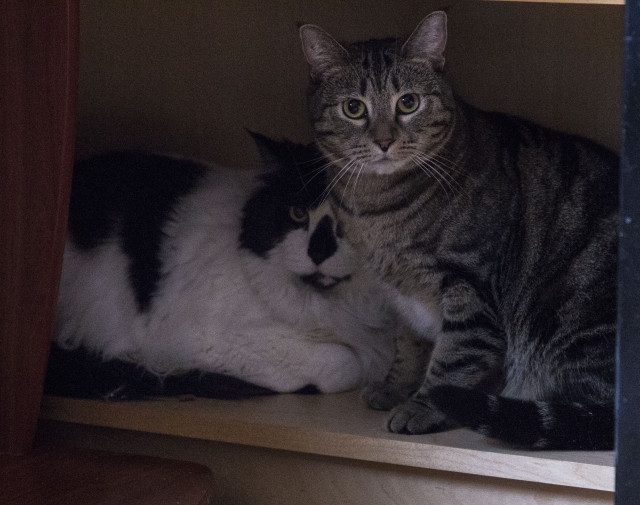
Raindrop and Steveston each grew up in difficult circumstances and came to us as semi-feral cats two years ago. They met in foster care where they became fast friends and are a great comfort to each other. They’re both still very shy, but we’re hoping an accepting and patient adopter will come along and open their heart and home to them.
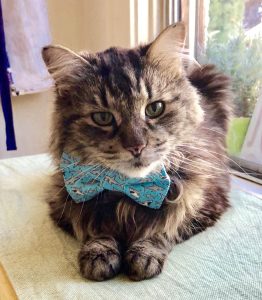 Rachel and her partner Chris already had three cats and were not looking to adopt another when they sat down to read the VOKRA newsletter together earlier this year. Living with Type 1 diabetes herself, the article on Timmy, an older male Maine Coon with diabetes, really resonated with Rachel. In fact, one of her previous cats also had diabetes so she was familiar with how to care for a diabetic cat. However, they were already short on space and were confident Timmy would find a forever home soon.
Rachel and her partner Chris already had three cats and were not looking to adopt another when they sat down to read the VOKRA newsletter together earlier this year. Living with Type 1 diabetes herself, the article on Timmy, an older male Maine Coon with diabetes, really resonated with Rachel. In fact, one of her previous cats also had diabetes so she was familiar with how to care for a diabetic cat. However, they were already short on space and were confident Timmy would find a forever home soon.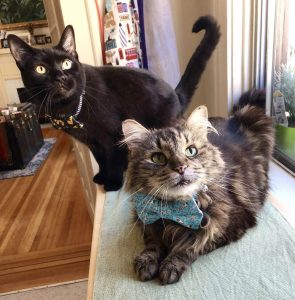 Visiting Timmy at his foster home (only five blocks from her own!), Rachel was able to review his lengthy medical files. It turns out Timmy had been a struggling diabetic without a permanent home for nearly seven years. Furthering her bond with him, Rachel learned Timmy was on the same insulin and required the same glucose checks as she did. Despite her concerns that adopting Timmy into their happy three cat home could potentially disrupt the other cats’ lives, Rachel knew the value of giving Timmy the opportunity for a happy, stable home overshadowed the risks. Rachel and Chris decided to take the plunge and take Timmy home.
Visiting Timmy at his foster home (only five blocks from her own!), Rachel was able to review his lengthy medical files. It turns out Timmy had been a struggling diabetic without a permanent home for nearly seven years. Furthering her bond with him, Rachel learned Timmy was on the same insulin and required the same glucose checks as she did. Despite her concerns that adopting Timmy into their happy three cat home could potentially disrupt the other cats’ lives, Rachel knew the value of giving Timmy the opportunity for a happy, stable home overshadowed the risks. Rachel and Chris decided to take the plunge and take Timmy home.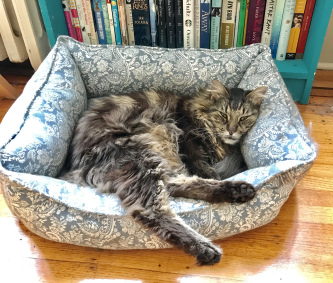 It took a month for all three cats to come around but Louie has now been accepted as part of the clowder. Louie’s a lover of all people food but is kept on a strict diet and schedule to manage his diabetes (even though Chris sneaks him a tiny taste here and there!). In fact, Louie’s diabetes has improved since his adoption and he now requires less daily units of insulin to manage his glucose levels.
It took a month for all three cats to come around but Louie has now been accepted as part of the clowder. Louie’s a lover of all people food but is kept on a strict diet and schedule to manage his diabetes (even though Chris sneaks him a tiny taste here and there!). In fact, Louie’s diabetes has improved since his adoption and he now requires less daily units of insulin to manage his glucose levels.